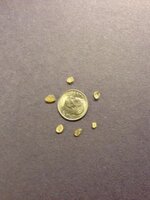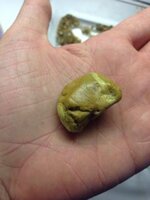Duckwalk
Hero Member
- Mar 21, 2014
- 966
- 1,312
- Detector(s) used
- 30" Bazooka Sniper, Drop Riffle sluice box.
Various Gold Pans
- Primary Interest:
- Prospecting
Getting into the gem hunting when I go prospecting. Big into gold prospecting. Hope you guys can help me out. I have no clue what these gems look like in the rough. Would love some pointers too!
I think the ones around the dime are topaz. Not sure what the other is with a stripe on the side, it is VERY smooth.


I think the ones around the dime are topaz. Not sure what the other is with a stripe on the side, it is VERY smooth.





 but gold pays better where as gems often come home with a good memory of the trip.
but gold pays better where as gems often come home with a good memory of the trip.
